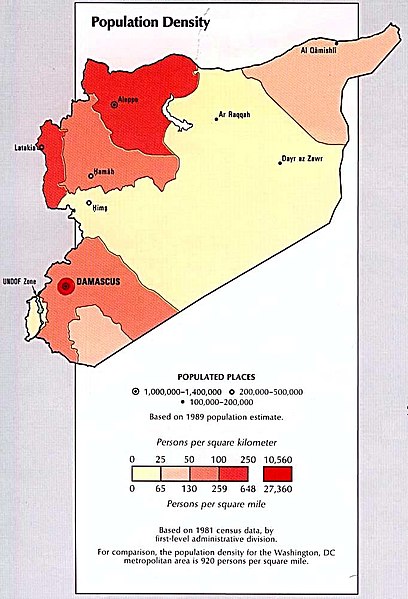The roughly 18 million inhabitants of Syria are an overall indigenous Levantine people. While modern-day Syrians are commonly described as Arabs by virtue of their modern-day language and bonds to Arab culture and history, they are, in fact, largely a blend of the various Semitic speaking groups indigenous to the region. Syria's population is 74% Sunni Muslim, other Muslims (including Alawites) make up 16% of the population, various Christian denominations make up 10% and finally, there are a few Jewish communities in Aleppo and Damascus.1,500 people of Greek descent live in Syria. The majority of them are Syrian citizens.
Arabic is the official, and most widely spoken, language. Arabic speakers make up 85% of the population (this includes some 500,000 Palestinians). Many educated Syrians also speak English and French. The Kurds, a majority of whom speak Kurdish, make up 9% of the population and live mostly in the northeast corner of Syria, as well in pockets all along the northern borders of Syria with Turkey, and demographically dominate the district of Afrin, west of Aleppo, though sizable Kurdish communities live in most major Syrian cities as well. Armenian and Turkmen are spoken among the small Armenian and Turkmen populations respectively. Aramaic is still spoken in two forms, The Syriac used by Assyrians and Western Neo-Aramaic used by Arameans inhabiting the villages of Bakh'a, Jubb'adin and Ma'loula.
60% of the population live in the province of Aleppo, the Euphrates valley or along the coastal plain; a fertile strip between the coastal mountains and the desert. Overall population density is about 118.3/km² (306.5 per sq. mi.) Education is free and compulsory from ages 6 to 11. Schooling consists of 6 years of primary education followed by a 3-year general or vocational training period and a 3-year academic or vocational program. The second 3-year period of academic training is required for university admission. Total enrollment at post-secondary schools is over 150,000. The literacy rate of Syrians aged 15 and older is 86.0% for males and 73.6% for females.
Vital statistics

UN estimates
CIA World Factbook demographic statistics

The following demographic statistics are from the CIA World Factbook, unless otherwise indicated.
Population
17,951,639 in 2014, a massive decrease due to 5 million refugees leaving the country because of the Syrian civil war and furthermore because of the death in war also.
Age structure
0â€"14 years: 35.2% (male 4,066,109/female 3,865,817)
15â€"64 years: 61% (male 6,985,067/female 6,753,619)
65 years and older: 3.8% (male 390,802/female 456,336) (2011 est.)
Median age
total
21.9 years male
21.7 years female
22.1 years (2011 est.)
Population growth rate
-0.797% (2012 est.)
Birth rate
2.35 births/1,000 population (2012 est.)
Death rate
3.67 deaths/1,000 population (July 2012 est.)
Net migration rate
-27.82 migrant(s)/1,000 population (2012 est.)
Sex ratio
at birth: 1.06 male(s)/female
under 15 years: 1.06 male(s)/female
15â€"64 years: 1.05 male(s)/female
65 years and older: 0.89 male(s)/female
total population: 1.05 male(s)/female (2009 est.)
Life expectancy at birth
total population: 71.19 years
male: 69.8 years
female: 72.68 years (2009 est.)
Nationality
noun: Syrian(s)
adjective: Syrian
Ethnic groups
Syrian Arabs and indigenous Syriac Arameans 90%, other ethnic groups such as Kurds 9%, Syriacs/Assyrians, Armenians, Circassians, and Syrian Turkmen, Greeks 1%
Religions
- 90% Muslims
- 74% Sunni Muslims
- 13% Other Muslims (including Alawi, Ismailis and Shi'a)
- 3% Druze
- 10% Christians (various denominations)
Languages
Arabic (official); Kurdish, Aramaic, Circassian (Adyge), and Armenian.
Literacy
definition: age 15 and older can read and write
- total population: 79.6% (2004 census)
- male: 86.0%
- female: 73.6%
Urbanization
- urban population: 56% of total population (2010)
- rate of urbanization: 2.5% annual rate of change (2010-15 est.)
Major cities - population
- Aleppo: 2.985 million
- Damascus (capital): 2.527 million
- Homs: 1.276 million
- Hama: 0.854 (2009)
References


